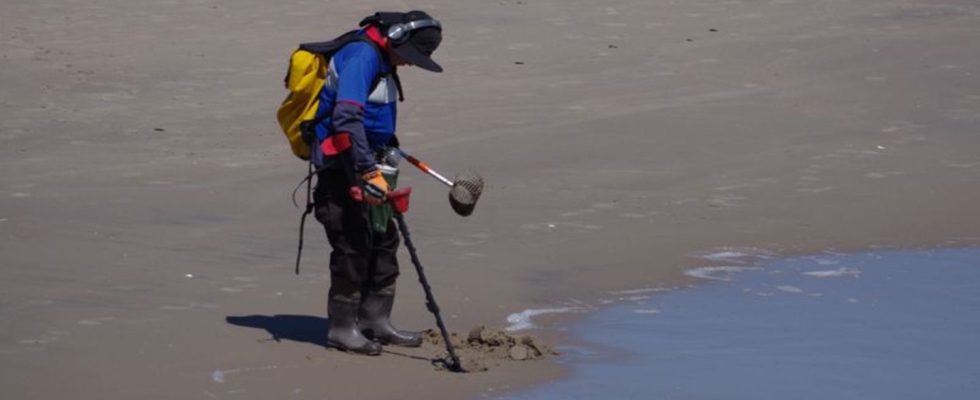prober
On a treasure hunt on the beach – the trend towards “spying” in New York
George Pessard with a metal detector, rubber boots, a strainer and two plastic bins on Coney Island beach. photo
© Luzia Geier/dpa
In New York, because of the skyscrapers, the gaze often first wanders upwards. But there is also history in the soil. If you want to find them, you need the right equipment – and a lot of patience.
With his bright yellow backpack and blue t-shirt, George Pessard looks a little like part of the iconic Coney Island scenery himself. The 73-year-old retiree didn’t come to South Brooklyn’s beach for a roller coaster ride or one of Nathan’s famous hot dogs. He is one of the many probers. Armed with a metal detector, rubber boots, a sieve, two plastic containers and an official permit from the city, George goes on a treasure hunt.
The so-called Sondeln enjoys growing popularity in New York – especially among men. Anyone out and about will sooner or later meet at least one of the approximately 500 city dwellers who have obtained a permit from the park administration. Certain rules apply to hobby treasure hunters, for example “significant objects” must be reported, the same applies to “identifiable property”. Central Park, among other places, is also off-limits. In the meantime, in 160 parks and on twelve beaches, you can happily explore, including in Coney Island.
“Ah!” exclaims George as his metal detector goes off and uses the sieve to scoop a load of sand off the beach. “That could be a quarter” (meaning a quarter). Depending on the noise and the so-called target ID on the display, experienced “metal detectorists” like him can roughly predict the size, shape and material of their finds. But only digging out gives clarity.
The really good finds come in winter
George shakes the sieve, sand and shells trickle out. What remains is a white, oval piece of metal – not a coin, just the patch of an anorak. Successful probing requires a lot of patience.
“For me it’s a challenge, a game,” explains George as he fishes the third bottle cap of the day out of the sand. He makes the really good finds – pieces of jewelry and rare coins – in winter anyway, when storms often carry fresh sand to the Atlantic shore. In April he is almost the only treasure hunter here. One of dozens in cold, wet winter weather.
On days like that you meet Merrill Kazanjian. The teacher, who describes himself as a “geek” (in German roughly nerd), has achieved a little fame in the scene: his YouTube channel “Metal Detecting NYC” has around 30,000 subscribers. In the humorously designed videos, he documents his finds and gives user tips on the latest technology. He also knows quite a bit about the different types of soil in New York.
He was particularly taken with the silent contemporary witnesses of New York’s history. “So many people from all over the world have stopped here over the centuries,” he enthuses, “and lost things.” For example, an elaborately decorated brooch with an engraving by Peer Smed: At the beginning of the 20th century, the Danish-born silversmith worked for well-known institutions such as the jeweler Tiffany & Co. and the luxury hotel Waldorf Astoria. Pieces he designed can now be found in the Metropolitan Museum of Art – and evidently on the shore east of Coney Island.
“I never expect to find treasure”
Merrill has also encountered so-called hard-times tokens a few times. The copper coins minted by hair salons, among others, were actually a kind of advertising gimmick in the 19th century: a token in exchange for a free haircut. However, when the banks ran out of cash in the wake of the economic crisis of 1837, the coins also functioned as unofficial currency for a short time.
Some finds from today’s Prospect Park are even older. In 1776, during the American Revolutionary War, the breakaway colonies there fought heavy battles with the British. Leftover musket bullets are stuck in the park’s soil, as are brass coins that passengers had to purchase for the New York subway before the Metrocard was introduced in the 1990s.
However, Merrill prefers to keep less well-known localities to himself, even if the videos would certainly get a lot of clicks. “We’re a friendly community, but also pretty secretive,” he laughs. A bit of competition is already involved. Above all, his hobby taught him to be mindful: “I never expect to find a treasure. If it happens that way, then I’m happy. And the great thing is: I can just keep looking.”

